#Biennale de Dakar
Explore tagged Tumblr posts
Text
Dakar: Il Cuore dell’Arte Africana Contemporanea con la Biennale di Dakar
La città di Dakar, capitale del Senegal, si è affermata negli ultimi decenni come uno dei centri più vivaci dell'arte africana contemporanea. Con la sua lunga tradizione culturale e artistica, Dakar rappresenta oggi un punto di riferimento per artisti emergenti e affermati, grazie soprattutto alla Biennale di Dakar (Dak’Art), uno degli eventi più prestigiosi dedicati alla creatività del continente africano.
La città di Dakar, capitale del Senegal, si è affermata negli ultimi decenni come uno dei centri più vivaci dell’arte africana contemporanea. Con la sua lunga tradizione culturale e artistica, Dakar rappresenta oggi un punto di riferimento per artisti emergenti e affermati, grazie soprattutto alla Biennale di Dakar (Dak’Art), uno degli eventi più prestigiosi dedicati alla creatività del…
#Aïda#Africa#africana#Alessandria#Arte#Artisti#Arts#ba#Biennale#Carlo#Cissé#Company#contemporanea#Cultura#Dakar#Dak’Art#d’Art#des#diaspora#emergenti#Esposizione#espressione#Fotografia#Galerie#gallerie#Google#identità#IFAN#Innovazione#italianewsmedia.com
0 notes
Text
de schuurman -- biennale dakar
2 notes
·
View notes
Text
Africa’s most celebrated dancer and choreographer, Germaine Acogny, turns 80 on 28 May. I have had the privilege of meeting the Senegalese artist, learning from her, and interviewing her as part of my ongoing research into African contemporary dance.
This is a hymn to an African woman who has inspired not only African dancers but a global community of artists to think differently about who they are, their bodies, their skin, and indeed the way they move.
In a continent plagued by legacies of colonisation, racism and patriarchy, Acogny has risen up as a female artist who has defied stereotypes around her Blackness, her femaleness and her long tall body, to become one of the world’s most revered dance makers.
Who is Germaine Acogny?
Born in 1944 in Porto Novo in Benin, Acogny moved with her family and settled in Senegal as a young girl. She is often referred to as Africa’s mother of contemporary dance, because of her long performing, teaching and choreographic career. She has built the legacy of a dance company, Jant-Bi, and her now globally recognised school and dance centre in Toubab Dialaw, Senegal, called École des Sables (Place in the Sand).
youtube
As a young girl in Dakar, Acogny attended Catholic school. Feeling alienated from the language, the religion and the colonial rituals, she took refuge in sport. This eventually led to her attending the Simon Siegel School for dance and sport in Paris in 1962. She set out to become a physical training teacher.
Encountering western dance for the first time, and being the only Black (and African) student in her class, she was made to feel that she was not “right” and her shape was “wrong”. Instead of being defeated, Acogny began to invent movements that corresponded to her own body. She told me:
I have taken my flat feet, my big behind and African woman’s hips, my tall west African body, and made this the centre.
A meeting with African American dancer Katherine Dunham, who was trying to establish a dance school in Senegal, was the final impetus for Acogny in her journey to find a dance language that spoke to her. The Germaine Acogny technique is now celebrated as one the first codified systems for training African urban or contemporary dancers.
Acogny has received numerous awards, among them a Golden Lion at the Venice Biennale and a Bessie Award in New York. She has been bestowed with multiple honours from the governments of both Senegal and France.
And she continues to tour the world with her work. While much of the running of her school now rests on her son Patrick Acogny, she also continues to teach and share her dance wisdom globally.
Contribution to contemporary dance
Understanding what Acogny has done for both dance training and performance leads to a reflection on the nature of contemporary dance. Difficult to define, contemporary dance is an open form with the intention to create new dance languages that engage the “contemporary” (the current moment).
In Africa this is a rich interplay between traditional dance forms, European and American modern dance histories and methodologies, and the ongoing search for authentic contemporary African voices that speak to ideas of culture, politics, self and identity.
South African dance writer Adrienne Sichel notes that this definition could further include contemporary dance’s “invention and reinvention of artistic and cultural forms and functions and its ability to disrupt, displace, connect and survive”.
Acogny was one of the first African dance makers to openly disrupt the European norm of a white, rail thin, weightless female dancing body. She actively sought ways to express her own Blackness and her own west African dance rhythms, and indeed her own gendered journey to finding a voice for herself. Her work often reflects on her own history and her embodied understanding that women’s bodies are often the greatest spoils of war, genocide and patriarchy.
Two great works
With her belief that we carry our histories in our bodies, two of Acogny’s dance works in particular stand out.
The first is a collaboration with Japanese dance maker Kota Yamakazi in 2004, with a work called Fagaala (Genocide). It journeys into the horrifying memory of the Rwandan genocide of 1994. This is a dance storytelling that offers a connection between the contemporary Japanese art form of Butoh (often called “the dance of death”) and Acogny’s own unique west African contemporary dance style.
In Fagaala, Acogny worked only with the male Senegalese dancers in her company and asked them to explore what it meant to be female and live through the Rwandan massacres. So, while the dancers were male, the work explored female stories. Male dancers had to physically and emotionally understand – and perform – the consequence of rape and torture, two tactics of the genocide. This means confronting the horror of men and war.
The second work is the deeply personal solo that Acogny created and performed in 2015 at the age of 71. Called Somewhere at the Beginning, this is Acogny’s journey back into her own maternal and paternal histories that criss-cross her dual west African heritages of Benin and Senegal.
She unearths the devastating visceral effects of colonial Christianity, while at the same time connecting with the suppressed power of her grandmother’s Yoruba spirituality. The work is a palimpsest of dance, video, text, and the layering of Black African female histories as she confronts loss and memory. Somewhere at the Beginning is significant not least for its unique feminist decolonial storytelling; it offers the audience the glorious, unprecedented body of an older African matriarch dancing truth to power.
As Acogny turns 80, this is an anthem of praise to the living legacy of a female dance maker who has helped shape Africa’s significant contribution to dance by rethinking bodies, histories and identity itself.
2 notes
·
View notes
Text

#Tourisme #Dakar #OCI #Sénégal La désignation de Dakar comme "Ville du Tourisme de l'OCI 2025" marque un tournant historique pour la capitale sénégalaise. Cette reconnaissance, obtenue lors de la 12ème Conférence Islamique des Ministres du Tourisme en Ouzbékistan, reflète l'engagement du Sénégal à promouvoir son patrimoine culturel et touristique sur la scène internationale. Dakar, avec ses plages idylliques, ses monuments historiques et sa scène culturelle dynamique, est désormais sous les projecteurs mondiaux. Cette distinction offre une opportunité unique de mettre en valeur la diversité des attractions touristiques de Dakar. Parmi les sites emblématiques figurent l'île de Gorée, inscrite au patrimoine mondial de l'UNESCO, le Monument de la Renaissance Africaine, et le Lac Rose, célèbre pour ses eaux rosées et sa production de sel. Ces lieux, riches en histoire et en beauté naturelle, incarnent l'essence du tourisme sénégalais. En outre, la ville propose une expérience culturelle immersive à travers ses marchés animés, ses festivals artistiques comme la Biennale de Dakar, et ses musées tels que le Musée Théodore-Monod d'Art Africain. Les autorités locales et nationales se mobilisent pour garantir le succès de cet événement d'envergure. Un comité spécial "Dakar 2025" a été mis en place afin de coordonner les activités et les investissements nécessaires. Parmi les initiatives prévues figurent la modernisation des infrastructures touristiques, le développement d'hôtels de luxe et de centres de congrès, ainsi que la promotion d'un tourisme durable et responsable. Ces efforts visent non seulement à attirer des millions de visiteurs mais aussi à renforcer l'économie locale grâce à des investissements significatifs dans le secteur touristique. Le choix de Dakar repose sur des critères d'excellence tels que la richesse de son patrimoine culturel et islamique, sa facilité d'accès grâce à des infrastructures modernes, et son engagement envers une croissance touristique durable. Cette distinction ouvre également des perspectives économiques considérables en exposant Dakar à un marché potentiel de voyageurs intra-OCI. En tant que "Ville du Tourisme 2025", Dakar se prépare à accueillir le monde avec son hospitalité légendaire tout en célébrant son patrimoine unique. Cette consécration renforce non seulement le positionnement du Sénégal comme destination touristique majeure mais aussi son rôle dans la promotion du tourisme islamique à l'échelle mondiale. Read the full article
0 notes
Text
Visite du Président Oligui à la Biennale des Arts de Dakar
En marge de son entrevue avec son homologue sénégalais, le Président de la Transition, le Général Brice Clotaire Oligui Nguema a, en compagnie de la Première Dame, Zita Oligui Nguema procédé à la visite d’une exposition de la Biennale des Arts au Grand théâtre national Doudou Ndiaye Coumba Rose de Dakar. Placée sous le thème « l’éveil », la 15e édition de la Biennale des Arts de Dakar a vu la…
0 notes
Text
Le Président Bassirou Diomaye Faye visite la 15e Biennale de l’Art Africain Contemporain à Dakar
Le Président Bassirou Diomaye Faye visite la 15e Biennale de l’Art Africain Contemporain à Dakar Dans le cadre de la 15e édition de la Biennale de l’Art Africain Contemporain, Dak’Art 2024, le Président Bassirou Diomaye Faye s’est rendu cet après-midi à l’ancien palais de justice de Dakar pour découvrir plusieurs expositions majeures : -L’exposition internationale**, rassemblant 58 artistes issus…
0 notes
Text





🌊 Rdv à Dakar où j’aurais le plaisir d’exposer un extrait de mon reportage « Les Sabliers de Bamako » réalisé au Mali et qui aborde l’extraction de sable au bord du fleuve Niger. . Dans le cadre du OFF de la Biennale de Dakar, je présenterai ce projet lors d’une exposition collective de la Fondation Maono où les artistes sont invités à explorer la pirogue comme symbole de transmission culturelle, de migration et d’échanges entre civilisations. Creative District conseille, accompagne et promeut des initiatives dans les industries créatives et culturelles. Je ferai également partie grâce à eux, de la résidence au Sénégal « La traversée des pirogues – Vecteur culturel dans le courant migratoire » afin de débuter la production d’une nouvelle série documentaire autour des femmes et de la mer sur l’île de Ngor.
La traversée devient ainsi une métaphore du voyage, de la quête identitaire et du dialogue interculturel. 📸 Belle découverte à tous, Aurore Vinot . #offbiennalededakar #exposition #résidence #sabliersdebamako #photographie #documentaire #afrique #migrationartistique #iledengor
0 notes
Text
Identité visuelle de la Biennale est désormais Interdite d’utilisation selon SG. Le secrétariat général de la Biennale de l’art africain contemporain de Dakar (Dak’Art) attire l’attention des porteurs de projets dits OFF sur l’interdiction d’utiliser toute identité visuelle de cet évènement culturel initialement prévu du prévue du 16 mai au 16 juin avant son report à une date ultérieure. Identité visuelle de la Biennale : Interdiction de son utilisation (SG) Biennale d’art africain contemporain de Dakar0 “L’utilisation de l’identité visuelle et de tout ou partie des éléments de la charte graphique de la 15e édition de la Biennale de l’art africain contemporain de Dakar est interdite par le secrétariat général”, peut-on lire dans le communiqué transmis à Kafunel. →A lire aussi La Biennale de Dakar se déroulera du 19 mai au 21 juin 2022 (Communiqué) Le texte qui cite le secrétaire général de la Biennale Mariama Ba, indique que cette mesure d’interdiction s’adresse “aux initiateurs des manifestations d’environnement communément appelées OFF”, en parlant d’une mise en garde contre “ceux qui ont décidé de maintenir leurs expositions malgré le report annoncé par la tutelle”. Prévue du 16 mai au 16 juin 2024, reportée à la période du 7 novembre au 7 décembre de la même année Biennale d’art africain contemporain de Dakar “Toute enfreinte à cette mesure obligatoire est passible de poursuites judiciaires”, souligne le document. La même source note que bien qu’étant “une proposition curatoriale”, la partie OFF “reste un volet de la programmation de la Biennale de Dakar”. Identité visuelle de la Biennale Interdiction de son utilisation (SG) →A lire aussi La célébration des 50 ans de carrière de Zulu Mbaye en octobre sera »une fête continentale » (artiste) La 15ᵉ édition de la Biennale de l’art africain contemporain de Dakar (Dak’art), initialement prévue du 16 mai au 16 juin 2024, a été reportée à la période du 7 novembre au 7 décembre de la même année.
0 notes
Text
Lavar Munroe's latest foray
View works.
Sviriko: Spirit Medium, 2023
Share
Lavar Munroe is a Bahamian interdisciplinary artist working primarily in mixed media painting, cardboard sculpture, and drawings. His work examines themes present in folklore, fables and historic films – drawing comparison between his upbringing in the Bahamas and travels to various countries in Africa. Addressing multiple narratives that span personal, historical and mythological references, Munroe’s work presents conflicts between a desire to escape and the longing for home while challenging us to journey beyond the familiar.
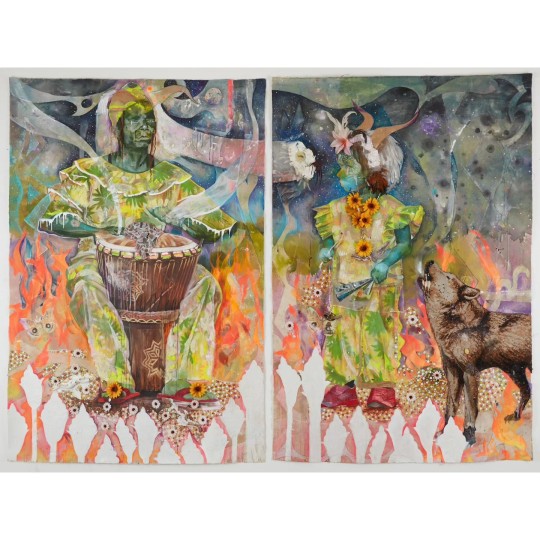
Described as a hybrid medium between painting and relief sculpture, Munroe’s work often incorporates sentimental objects collected and gifted from his family and objects found during his travels. His work focuses on themes such as journey, utopia, magic, love and the celebration of escape through fantastical and dreamlike imagery. Munroe (b.1982, Nassau, Bahamas) earned his BFA from Savannah College of Art and Design (2007) and MFA Studio Art at Washington University, St. Louis (2013). He also attended Skowhegan School of Painting and Sculpture (2013) and was awarded a postdoctoral research fellow at the University of North Carolina, Chapel Hill (2016), Benny Andrews Fellow from the MacDowell Colony (2016), and The Carolina Postdoctoral Program for Faculty Diversity-University of North Carolina, Chapel Hill NC (2014).
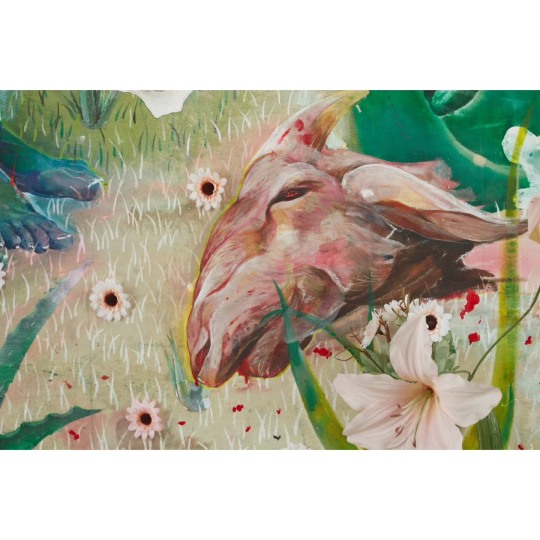
Recent solo exhibitions include Jack Bell Gallery, London, England (2022, 2021, 2014); Walters Museum of Art, Baltimore, MD (2021); NOMAD, Brussels, Belgium (2017); Meadows Museum of Art, Shreveport, LA (2018); SCAD Museum of Art and Gutstein Gallery, Savannah, GA (2016); and The Central Bank, Nassau, Bahamas (2010). Notable group shows include The National Art Gallery of the Bahamas (2022); Centre Pompidou Metz, FR (2022); Ichihara Lakeside Museum (2020); Virginia Museum of Contemporary Art, Virginia Beach, VA (2020); Perez Art Museum Miami, FL (2019); Jack Bell Gallery, London, UK (2017); and Nasher Museum of Art, Durham, NC (2015). He has also been featured in the Art Basel Miami Beach (2022); Kampala Biennale (2020); Off Biennale Cairo (2018); 12th Dakar Biennale, Senegal, West Africa (2016); and 56th Venice Art Biennale (2015). His work is in the collections of The Baltimore Museum of Art, Fondation de France; Fondation Gandur pour l’Art, Genève, Switzerland; The Studio Museum of Harlem, New York, NY; The Central Bank of the Bahamas, Nassau, BA; The National Art Gallery of the Bahamas, Nassau, BA; and the MAXXI Museum, Rome, IT.
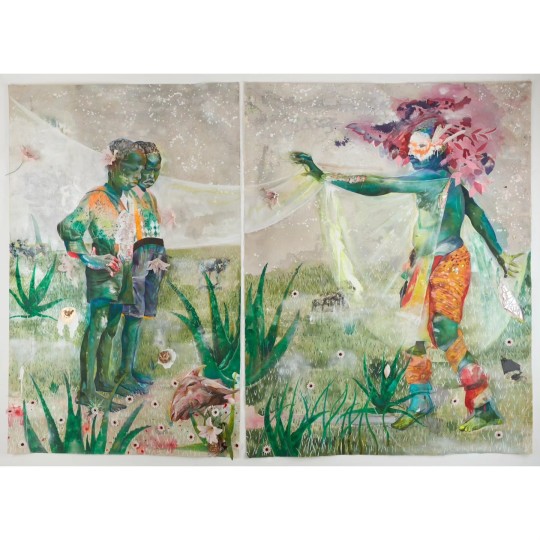
He is the recipient of honors and awards including the John Simon Guggenheim Memorial Foundation Fellow, Robert De Niro Award (2023), the Sondheim Artscape Prize Finalist (2021), Distinguished Alums Award from Sam Fox School of Art and Design from Washington University of St. Louis (2018), Postdoctoral Award for Research Excellence from the University of North Carolina (2015), Sam Fox Dean’s Initiative Fund (2013), Joan Mitchell Foundation Painters and Sculptors Grant (2013), Joan Mitchell Foundation Scholarship (2012), The Kraus Family Foundation Award (2011), and The National Endowment for the Arts Grant (2011).
Munroe lives and works between Baltimore, MD, and the Bahamas.
#sexypink/Lavar Munroe#sexypink/Bahamian Artist#sexypink/multi media artist#sexypink/Bahamian Art#tumblr/lavar Munroe#Lavar Munroe#Bahamian Art#Bahamian Artist
1 note
·
View note
Photo

Hi everyone ! I’m happy to tell you that Cahiers Manufactoriel will have a booth at African Art Book Fair 2018 in Dakar (Senegal) along side with publishers as
AFRIKADAA (France/Cameroun).
Africalia Edition (Belgique).
Bandjoun Station Editions (Cameroun).
Biennale de Dakar (Sénégal).
CCA Lagos (Nigeria).
Teham Éditions (Cameroun/France).
Chimurenga (Afrique du Sud).
Duta Editions (Cameroun).
Editions Malika Slaoui (Maroc).
Galerie Imane Farès Editions (France).
Les éditions Ifrikiya (Cameroun).
Les Éditions Clémentine De La Ferronnière (France).
Market FiftyFour (Pays-Bas/Ethiopie).
Mosaïques Editions (Cameroun).
Nka Journal of Contemporary African Art (USA).
Pathways For Free Education (Afrique du Sud).
Revue Noire (France)
Sugarcane magazine (USA)
Something we Africans got (France).
Tiwani Contemporary (Angleterre).
Visiter l’Afrique (Cameroun).
Vus d’Afrique Editions (France/Cameroun).
Zaman Editions (France).
Nouvelles Editions Zola Place (France).
Cahiers Manufactoriel will exhibit and sell the artists’ books of Neals Niat @nealsniat and Salwat Idi @salvvat in Dakar at African Art Book Fair 2018 during la Biennale d’Art Africain Contemporain de Dakar also named as Dak’art 2018.
It is a honor to participate in such a powerful event and we are grateful to be able to show what we have been working on, there.
Sharing is caring. Sharing is showing empathy. Curating ( the action of “to curate”, from the Latin word curare which means to take care of ) is also a participative process.
If you like our work share it to a friend, share it on social media, share it to the world. This is one proprosition of how you can be a part of our curating and creative process URL and IRL.
Tell a friend to come discover our creative experience through Cahiers Manufactoriel and the beautiful and mindful artists’s books Zingatia by Salwat Idi and Life Scenes and Exode Rural by Neals Niat at Centre Culturel Douta Seck in Dakar!
Salwat Idi the author of Zingatia will represent Manufactoriel for the 3 days and will gladly give a talk, on the topic : Autoedition and new issues of publishing, moderated by art critic and curator Yves Chatap. Come meet her !
Venue : Douta Seck Cultural Center – Avenue Blaise Diagne X Rue 25 BP 7559, Médina – Dakar. Opening hours: from 10 am to 7pm from the 3rd to the 6th of May 2018
Join us : Salwat Idi : Twitter / Instagram / Tumblr
Neals Niat: Twitter / Instagram / Tumblr
Manufactoriel Twitter / Instagram / Tumblr
manufactoriel.com
#AABF#AABF2018#African Art Book Fair 2018#African Art Book Fair#Manufactoriel#Cahiers Manufactoriel#Senegal#Dakar#Dak'art 2018#biennale de dakar 2018#Biennale de Dakar#Biennale de l'art africain contemporain#Art africain contemporain#African contemporary art#Book fair#Art Book Fair#salwat Idi#neals niat#tounzi#life scenes#zingatia#exode rural
61 notes
·
View notes
Text
Hello Everyone! I went to Senegal for 6 months and have shared all my adventures via Instagram stories at the time.
So, I recently created a Tiktok account b/c close friends encouraged me. Now, I decided that I will reshare all my adventures on TikTok as well - 1) because I created so much content 2) I can use the TikTok content as a capsule for a lot of context and information and 3) I can consistently post on the app while learning how the application works and how the people react to my content.
http://www.tiktok.com/@senegalesetwisted
https://www.instagram.com/senegalesetwisted/
I would love for you to support me w/ a follow on Instagram and TikTok @senegalesetwisted. Especially if you are interested in Senegal, want to travel to Senegal or just are interested in the content/me. If you have any questions about Senegal, definitely ask away too. I will from time to time post some of the content here too.
♥️♥️
#senegal#senegalesetwisted#sntwistedphoto#sntwistedtravel#black women#africa#african diaspora#black people#black art#dakar biennale#dakar biennale 2022#dakart#art#african art#ancient palais de justice#museum of black civilizations dakar#abdoulaye konate
15 notes
·
View notes
Text
Abdoulaye DIALLO alias Le berger de l’ile de N’Gor sera à la bibliothèque de l’université Cheikh Anta DIOP à Dakar du 3 Mai au 2 Juin 2018. Le commissariat de l’exposition sera assuré par le Professeur Magueye KASSE de l’université Cheikh Anta DIOP. Le 2 Mai se tiendra au Terrou bi (salon des princes), à partir de 9h, une table ronde sur le thème :”Quelle humanité pour demain ?” en prélude au VERNISSAGE prévu le 5 Mai à 16h, à la bibliothèque de l’université Cheikh Anta DIOP. Cette exposition était visible en septembre 2017 dans la villa – galerie de l’artiste, sur la 2e plage de l’île de Ngor. Théodora SY SAMBOU y avait fait un tour. Africulturelle reprend ici, cette critique publiée à l’origine dans Sud Quotidien
This slideshow requires JavaScript.
Jeu de hasard et Jeux de couleurs
Il est fasciné par les chiffres, les opérations mathématiques, les codes et les symboles, et disons que les 9 mois de gestation, le «rivage du futur» comme il dit de façon très poétique, lui font aussi cet effet-là. Ses matériaux ne sont pas très conventionnels, l’huile de palme, le «sang de cactus», les grains de mil, le thé ou le café…Comme dans une cuisine expérimentale. Il aime le jeu, il dit du hasard que c’est son «premier assistant», il a 65 ans, et il s’est lancé dans la peinture à 60 ans. Abdoulaye Diallo, ou «Le berger de l’île de Ngor», expose dans sa villa-galerie, là-bas sur la «2ème plage de Ngor». Allez donc voir !

”Quelle humanité pour demain”? de Abdoulaye DIALLO
On y entre, un pas devant l’autre et les pieds nus, comme dans un sanctuaire, ou presque…Pas parce que le maître des lieux est du genre à chipoter, non, ce serait plutôt sa façon à lui de vous mettre à l’aise, dans cette bâtisse rouge brique qui a les pieds dans l’eau, là-bas sur la «2ème plage» de l’île de Ngor. C’est ce que raconte la translucide carte de visite de l’«artiste», Abdoulaye Diallo, que l’étiquette a d’ailleurs l’air de faire sourire, lui qui s’est plus ou moins lancé à l’âge de 60 ans, comme au poker. Son exposition ferait presque songer à l’œuvre d’une vie : il a un souvenir ou un bout d’histoire avec chacune de ses toiles, passe de l’une à l’autre comme s’il papillonnait, avec cette façon qu’il a de se mouvoir, un peu comme s’il dansait une sorte de valse sans conventions, sur le sol de cette galerie improvisée…Où l’on entre surtout pour les beaux yeux de cette toile-là, qui a d’ailleurs prêté son nom à l’expo elle-même («Quelle humanité pour demain ?»), en se jouant plus ou moins de l’intitulé de l’exposition internationale de la toute prochaine Biennale de 2018 : «Une nouvelle humanité».
Abdoulaye Diallo joue le jeu et accepte donc de nous introduire, jusqu’à la pièce maîtresse de son expo, avec l’air de scruter le monde derrière sa petite paire de lunettes rondes à la «Salvador Dali».
A elle seule, l’œuvre («7, 9m de long et 2, 45m de large»), qui fait parfois songer à un mur craquelé, fissuré, exprime la soupçonneuse lecture d’un artiste inquiet, qui a un discours sur un millier de choses à la fois, et autant de tiroirs ouverts, qu’il ne cherche même pas à contrôler. Car avec lui, on a le sentiment d’être face à une sorte de brainstorming permanent. Une suspicion contre certaines (fumeuses ?) théories, qui voudraient que l’urine ait des vertus insoupçonnées, un discours radicalement contre la pédophilie, superposé à une représentation animalisée de terroristes à ceinture d’explosifs : une meute de loups, ou presque.
L’artiste se sert justement de ce procédé, l’animalisation, pour exprimer l’ambivalence de certains de ses personnages. Exemple avec cette toile intitulée «Les Demoiselles de Khou Roum Bouki» comme «Les Demoiselles d’Avignon» (1907) de Pablo Picasso. Dans l’une comme dans l’autre, une histoire faite de prostitution et de maladie, mais avec moins de «brutalité expressive» dans l’œuvre de Abdoulaye Diallo.
Des codes et des symboles, des chiffres et des lettres
«Kkou Roum Bouki», comme l’autre nom de cette «vallée des années 1940», «entre Pikine et Thiaroye», qui servait de repère aux hyènes, jusqu’à ce que «l’homme finisse par y remplacer l’animal», ou jusqu’à ce que l’animal cède la place à de «petits voyous» qui s’en prenaient alors à de pauvres jeunes femmes sans défense, violées qu’elles étaient par ces malfrats chez qui elles retournaient comme si elles n’avaient «pas d’autre choix», et avec sur le dos, le «poids de la honte». C’est cette douloureuse histoire que raconte l’artiste, mais avec délicatesse et subtilité, se contentant de suggérer, même si les silhouettes sont nues, d’un trait qui a pourtant l’air de se retenir ; peut-être par respect pour les victimes. Pendant que les bourreaux, dans cette représentation volontairement à charge, sont des personnages hybrides à tête d’hyène.
Arguments à l’appui, Abdoulaye Diallo passe aux aveux : «J’aime la Femme», une confidence presque philosophique, qui s’accroche à cette fascination que l’artiste a pour les 9 mois de gestation, le mystère de la vie ou le «rivage du futur», comme il dit de façon très poétique.
Idem pour les chiffres, qui lui font aussi cet effet-là, à lui le «talibé tidiane», passionné de «numérologie islamique» et de mathématiques, et dont les œuvres elles-mêmes sont pleines de chiffres, d’opérations mathématiques, de références à la science, de codes et de symboles…Comme ce «43», sur cette toile-hommage à Nelson Mandela ; 43, comme les longues années d’apartheid, cette «sombre période d’Afrique du Sud», et «46664», comme le numéro de matricule de Mandela.
Mais allez donc voir par vous-mêmes : vous y trouverez cet hommage-là, aux tirailleurs sénégalais, sa façon à lui de «provoquer Marine Le Pen», la présidente du Front National (FN)…Et peut-être l’entendrez-vous regretter que les seconds tours de nos élections présidentielles ne ressemblent ni plus ni moins qu’à un «gâteau que l’on se partage », ou à une querelle de bêtes sauvages.
Quant à ses matériaux, disons que le peintre n’est pas du genre très conventionnel : l’acrylique, le café, les feuilles de thé à la place des cheveux de ses personnages, Mandela par exemple, l’huile de palme, utilisée la toute «première fois sur une toile représentant la fin d’une cérémonie d’initiation», le «sang de cactus», les grains de mil, etc. Comme dans une cuisine expérimentale.
De la part d’un artiste qui dit du «hasard» que c’est son «premier assistant», l’on n’en attendait pas moins. Un jeu devenu «sérieux», un peintre qui tient comme à un sacerdoce à ses «9 couches» de peinture («Je respecte ce procédé» dit-il), et où les toiles elles-mêmes, que l’on prendrait pour des couvertures de livres, ou pour des affiches de film d’animation, prennent le temps de «sécher pendant plusieurs semaines».
Un bain de soleil et les pieds dans l’eau, là-bas, sur la «2ème plage de Ngor».
Théodora SY SAMBOU
Dak’Art 2018 : «Quelle humanité pour demain?», une exposition du peintre Abdoulaye DIALLO à l’Université Cheikh Anta Diop de Dakar
#Abdoulaye Diallo Berger de l&039;île de Ngor#afrique#art#arts#Biennale de Dakar#culture#DAK&039;ART 2018
0 notes
Photo

Ancien Palais de Justice at the Dakar Biennale, a piece by French artist Beya Gille Gacha is on display.
Photographer: Annika Hammerschlag
#annika hammerschlag#photographer#french artist#artist#art#beya gille gacha#sculpture#ancien palais de justice#dakar biennale#travel#culture
0 notes
Text
Visite du Président Oligui à la Biennale des Arts de Dakar
En marge de son entrevue avec son homologue sénégalais, le Président de la Transition, le Général Brice Clotaire Oligui Nguema a, en compagnie de la Première Dame, Zita Oligui Nguema procédé à la visite d’une exposition de la Biennale des Arts au Grand théâtre national Doudou Ndiaye Coumba Rose de Dakar. Placée sous le thème “l’éveil”, la 15e édition de la Biennale des Arts de Dakar a vu la…
0 notes
Photo
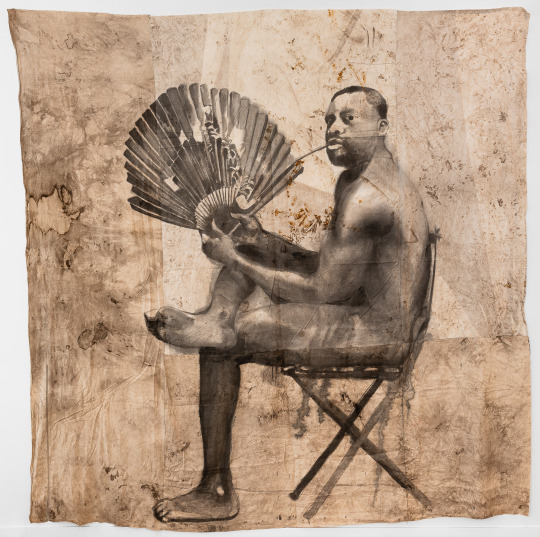
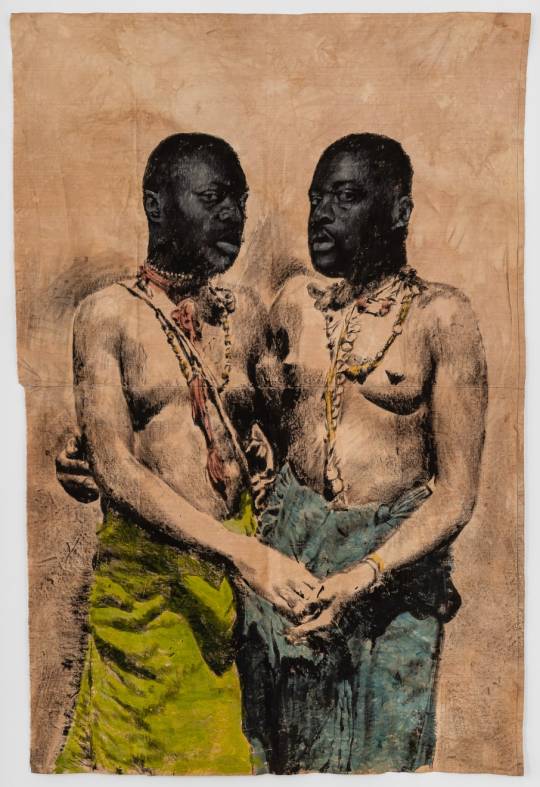

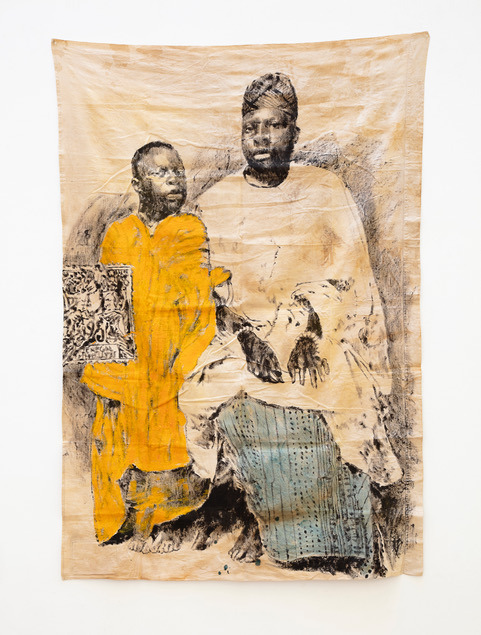

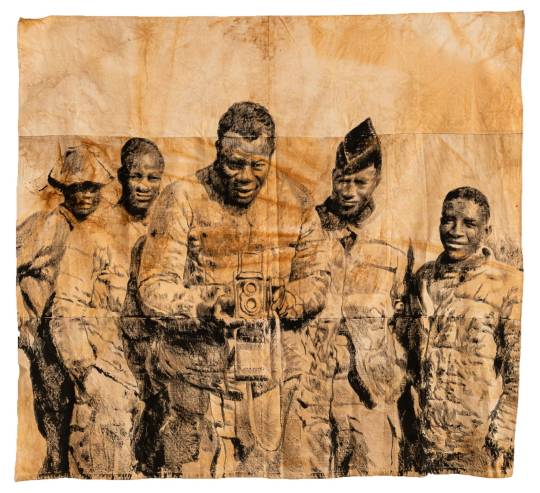



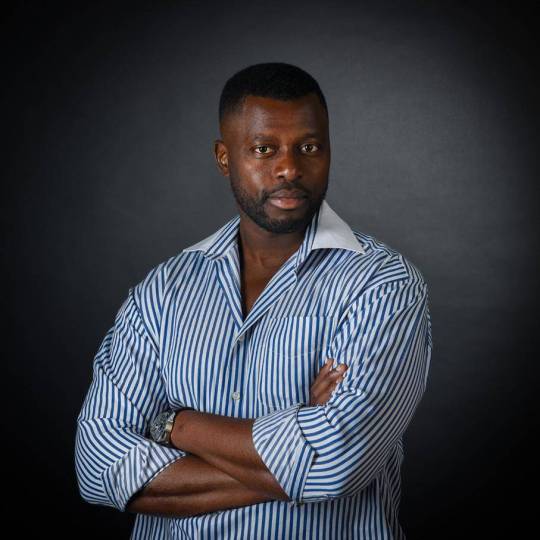
Born in 1986 in Bouaké (Ivory Coast), Roméo Mivekannin lives and works between Toulouse (France) and Cotonou (Benin).
After training as a cabinetmaker and studying art history, Roméo Mivekannin chose to enter the Ecole Nationale Supérieure d’Architecture de Toulouse. In parallel to his studies, he experimented with several mediums, from sculpture to painting.
Recent exhibitions: Paris + Basel (Paris, 2022); Effractions, Galerie Cécile Fakhoury (Abidjan, 2022); FITE, Musée Bargoin (Clermont-Ferrand, 2022); Picasso Remix, Biennale de Dakar, Dakar (Senegal, 2022); Zoos humains, Africa Museum, Tervuren (Belgium, 2021); Re-création, Fondation Blachère (France, 2021); Hosties Noires, Galerie Cécile Fakhoury, Dakar (Senegal, 2021); 1-54 Paris, Christie’s, Paris (France, 2021 and 2022); Les Âmes du peuple noir, Galerie Cécile Fakhoury, Abidjan (Ivory Coast, 2020)
https://cecilefakhoury.com/.../93-romeo-mivekannin/works/
24 notes
·
View notes
Photo

Exposition en Off à la biennale de Dakar. Venez rencontrer l'artiste Samba Diallo ce samedi 28 Mai 2022 lors du vernissage à l'hôtel Nina. Follow us on Facebook, Instagram, Pinterest and Twitter: @blawoarts www.blawo.art #blawo #blackartintheworld #blackart #africanart #blackpainting
1 note
·
View note